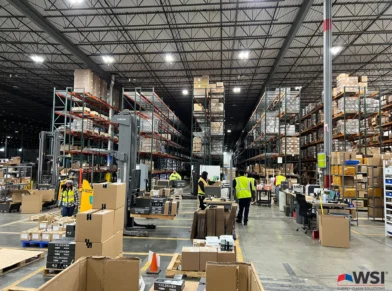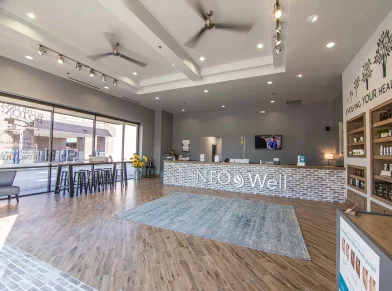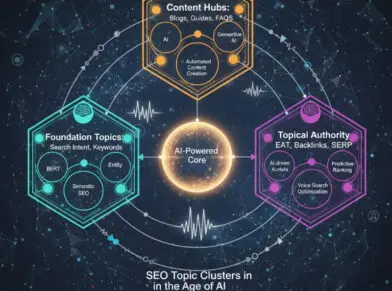The Ultimate Guide to Link Building for Marketing Success

What is Link Building?
In its most basic form, link building is the process of acquiring hyperlinks from other websites to your own.
It’s considered to be one of the key pillars of SEO success, a fact that Google’s Andrey Lipattsev himself confirmed in a web seminar. The Search Quality Senior Strategist at Google revealed that links, content, and RankBrain are the top three ranking signals in Google’s search algorithm.
But, that’s not all there is to link building. You see, links are like the digital version of word-of-mouth marketing. Building them not only boosts your SEO, but also spreads brand awareness, attracts referral traffic, and establishes industry credibility.
Make no mistake about it, though. Link building is not as simple as scattering hyperlink breadcrumbs across the web. The most impactful links are those that are relevant, high-quality, and organically integrated. Such links are not forcibly embedded or purchased – rather, they’re earned based on the value of your content and the relationships you’ve nurtured.
This guide explains exactly how you can achieve these valuable links. Read on to discover the best SEO linking strategies to include in your digital marketing plan, the benefits they bring to your marketing efforts, plus the common mistakes to avoid.
And to help you make sense of it all, let’s start with the basics of link building. This is where we go into the detail of what is link building, and the role that quality link building plays in SEO.
Understanding the Basics of Link Building
Links come in two principal flavors – internal and external.
Internal links are the ones that connect pages within the same domain. Their job is to help visitors navigate your website. They direct them from one piece of content to another in a logical and intuitive way.
External links, on the other hand, connect other domains to your website. They’re otherwise known as backlinks or incoming links, and their role is to point out references. Whenever a website publishes your backlink, they’re basically identifying your website as the go-to authority on the subject matter.
Search engines like Google view these backlinks as votes of confidence. They interpret each as a sign that the link destination page has been vetted and qualified as a credible reference. It’s a bit like being the popular kid in school. The more people like you (or in this case, link to you), the more visibility and recognition you get.
Link Signals and How They Influence SEO
In the context of SEO, link building is not about who can make the most moves, but rather who can execute each move with precision and grace. Each backlink you acquire sends a distinct set of signals to search engines. The signals are then evaluated separately, and the SEO weight of each backlink is ultimately calculated based on a range of factors.
Search engine algorithms typically consider factors such as:
- Link Quantity: Search engines calculate the number of links pointing to a website and then interpret the total volume as an indication of its popularity and trustworthiness. Building more links may therefore have a positive influence on your SEO.
- Link Quality: The quality of the backlink matters just as much, if not more, than the quantity. Quality links are identified by evaluating the history of the linking domain, the relevance of the linking page, and the credibility of the linking source. High-quality links from authoritative and contextually-related websites are the ones that pack the strongest SEO punch.
- Anchor Text: Anchor text, which is the clickable text in a hyperlink, helps search engines understand the context of the destination page. But, while optimizing anchor text with relevant keywords can boost the SEO value of the target page, overdoing it may raise red flags.
- Link Diversity: A diverse link profile – with links coming from varied domains, IP addresses, and website types – is a boon for SEO. It represents a natural link-building pattern, thus minimizing the risk of being marked for shady “black hat” link-building tactics.
To improve search engine rankings you want links that are:
- High-quality, relevant, and natural.
- Anchored to contextual keywords.
- Diverse.
- Plentiful.
Types of Links: Natural, Manual, and Self-Created
Now that you can answer the question “what is link building?” let’s review the three types of links you can pursue:
- Natural Links: These are the backlinks you earn from other websites without any direct solicitation. You can build them by creating authoritative content that’s worth linking to.
- Manual Links: These are the links you actively seek out through outreach efforts. You could, for instance, collaborate with industry bloggers, influencers, or journalists on link exchange programs.
- Self-Created Links: Also known as non-editorial links, self-created links are built by website owners in an attempt to trick search engines. They are often integrated into blog comments, press releases, guest posts, advertorials, and infographics.
Benefits of Link Building for Marketing
Whereas link building is often associated with SEO, it’s one of those digital marketing strategies that have multiple benefits. Here are some of the positive impacts link building has on a website:
#1. Improves Organic Search Rankings
Securing quality backlinks from authoritative websites is like getting a vote of confidence in your industry. Search engines interpret such links as indicators of your site’s credibility and relevance, thereby elevating your organic search rankings.
Through this entire journey, anchor text provides search engines with context about your page. You can thus optimize hyperlinks with relevant keywords to enhance the SEO value of your page.
#2. Increases Website Traffic and Referrals
Once you’ve published a permanent backlink on an authoritative site, you stand to attract a steady stream of referral traffic. And unlike traditional advertising campaigns that cease to generate traffic once they end, high-quality backlinks can maintain a continuous flow of traffic from external sources.
Other than that, link building can drastically boost website visibility and exposure. As your site rises in search engine rankings, it pulls in more potential customers – translating to increased sales and revenue.
#3. Reinforces Brand Authority and Credibility
Google is not the only entity that recognizes endorsements from quality SEO linking. The links influence others as well.
Whenever they come across your backlinks on authoritative platforms, web visitors begin to associate your brand with trustworthiness and reliability. This positive perception may then accelerate your engagement, conversions, and customer loyalty – further cementing your brand’s market dominance.
#4. Expands Online Visibility and Reach
Link building can also significantly amplify your brand’s online visibility and reach.
It turns out that the more your site is linked to on other sites, the more likely you are to attract additional links and traffic. This has a cascading effect, where increased visibility triggers even more page views, which can lead to exponential business growth.
The same link-building has the potential to generate opportunities for guest blogging, speaking engagements, or media coverage – all of which you could leverage for additional online visibility. Then if you manage to get your links published by websites that have a strong social media presence, your content will be shared widely with a large audience.
#5. Grows Conversions and Sales
As quality SEO linking propels your site higher in the search results, it’s expected to attract more potential customers – which should ultimately translate to increased sales and revenue.
You’ll also be seeing more conversions coming your way by virtue of being a leader in your industry. Customers find it easy to trust authoritative brands, a position that you’ll get through sustained link building.
Strategies and Techniques for Effective Link Building
Over the past two decades, link building has transitioned from an anything goes proposition to a methodology focused on earning links via high-quality content and strategic outreach.
This drastic shift has made the process of link building a bit more challenging. But then again, its exclusivity has turned it into an even more powerful tool for enhancing your website’s visibility, credibility, and organic reach. You just need to set yourself apart with the right strategies and techniques, explored below.
Creating High-Quality, Relevant Content
What is link building without content?
The cornerstone of any successful link building strategy is high-quality content. This is the bait that lures other websites and convinces them to link to your own. And to be specific, the biggest magnets for backlinks are those exceptionally insightful content pieces that are well-researched, highly engaging, and full of unique perspectives.
Such content usually resonates with the interests and necessities of the target audience. It addresses their concerns, proposes relevant solutions, and provides authentic value.
To discover the best content opportunities in your industry, you could bring in tools like Google Keyword Planner, SEMrush, or Moz Keyword Explorer. They’ll reveal keywords that have a strong search volume but present low competition.
Then when it comes to writing, we’d advise you to conduct in-depth research on your chosen subject while verifying the accuracy of the insights. All your arguments should further be supported by credible sources, statistics, and examples.
You might also want to incorporate well-structured headings, bullet points, and paragraphs for the sake of readability. Then to attract even more engagement, consider complementing the text with multimedia elements such as images, infographics, videos, or charts.
When the content piece finally goes live, remember to promote it extensively for increased visibility. The more people it reaches, the more likely you are to attract natural links. So, you can go ahead and engage audiences through social media, email marketing, and content syndication, or maybe reach out to influencers, bloggers, and media publishers in your niche.
Leveraging Guest Blogging and Influencer Outreach
Guest blogging and influencer outreach are two other powerful strategies for link building.
Guest blogging, for starters, entails creating and publishing content on other websites within your industry or niche. You could thus incorporate your backlinks into the text or author’s bio, and then get the articles published on authoritative websites for optimum gains in link juice.
Influencer outreach, on the other hand, tries to foster relationships with industry influencers, in the hope that partnering with them will earn you backlinks and increase brand visibility.
If you choose to give it a try, your best growth chances would be with celebrated influencers who command a highly dedicated and engaged following. You could then get them to promote your stuff through sponsored content, reviews, or interviews. All the endorsements from such influencers will serve as social proof for your brand, potentially leading to improved visibility and organic backlinks.
In both guest blogging and influencer outreach, you should try to partner with authoritative entities that resonate with your target audience. So, take the time to investigate your options by their online presence, content quality, engagement rates, and audience demographics. Tools like Ahrefs, Moz, BuzzSumo, or NinjaOutreach can help.
Building Relationships and Networking
If you manage to establish genuine connections with website owners, bloggers, influencers, and industry professionals, they’ll provide you with valuable opportunities for backlinks, guest blogging, and collaborative content creation.
These relationships are not just for the short term. By continually providing value and nurturing the connections, you could maintain all those link building partnerships for the long haul.
The networks will even support you with content amplification. You could request them to share and promote your publications among their audiences – thereby sparking more visibility, organic backlinks, and social media engagement.
To build such relationships, start by identifying thought leaders in areas that complement your specialties. You could even use social media platforms, industry forums, conferences, and tools like BuzzSumo or NinjaOutreach to discover them.
Once you’ve identified potential contacts, use a calculated approach to get noticed and build rapport. Engage with them on social media platforms, leave thoughtful comments on their blog posts, share their content, and engage in meaningful conversations.
Remember, the key to building relationships is providing value. So, to capture authoritative prospects, you should always find mutually beneficial ways of collaborating.
Utilizing Social Media for Link Building
Social media platforms, with their multi-billion active users, present a vast avenue for expanding your link-building reach and content visibility.
You’ll find opportunities for fostering relationships and networking with industry professionals, influencers, and potential link partners. You can also leverage content amplification to boost discoverability and potentially attract natural backlinks from a wide audience.
Now, to exploit social media for link building, begin by crafting high-quality, share-worthy content on your website. You can embed social sharing buttons on your website, as well as incorporate CTAs into your blog posts to motivate readers to share the content. The featured post layout itself should be designed in a manner that teases audiences with visually captivating content snippets.
Earning Links through Public Relations and Press Releases
Use press releases to broadcast your brand’s noteworthy events, product launches, industry insights, or significant achievements. The idea here is to get the attention of news outlets and industry publications, in the hope that they’ll feature your story in the media. Every single time you’re published is basically an opportunity to boost your brand’s credibility and build high DA backlinks.
By regularly sharing valuable and newsworthy information, your brand will progressively increase its odds of getting published. Your ever-growing presence could even pique the interest of journalists, bloggers, and influencers – who might then start to treat your brand as a reliable source of industry news.
Do some research and generate a list of newsworthy items about your brand and industry including events, milestones, product introductions, and industry revelations, etc. Next, find the best publishers to share them with. Find journalists, bloggers, and influencers who specialize in your industry. You’ll need someone with a large online presence, a highly engaged audience, and content that complements your published topics.
Link Building Best Practices and Tips
Conduct Competitor Backlink Analysis
An analysis of your competitors’ backlinks may yield invaluable insights into their link building strategies – including link patterns, anchor text distribution, and the types of websites they target for backlinks.
Such info can be a springboard for enhancing your own link building strategy. You might, for instance, discover types of content or topics that they’ve garnered backlinks from, identify content gaps, uncover unique perspectives, or brainstorm ways to refine publications on your website.
You’ll find the data in the backlink analysis sections of SEO research tool suites like Ahrefs, SEMrush, Moz, or Majestic.
Avoid Black Hat Link Building Techniques
Although the prospect of quick wins may appear attractive, resorting to black hat techniques exposes your website to all sorts of penalties – which may ultimately lead to a drop in rankings, diminished visibility, or even removal from search engine results.
Bouncing back from such penalties is anything but easy. And that’s if you even manage to recover in the first place.
Some of the most common black hat stumbling blocks that you might want to avoid include:
- Link Farms: Link farms are networks of thin websites that have been built exclusively to host tons of low-quality links.
- Paid Links: According to Google, paid links are those backlinks procured from third-party websites or link networks. Payment could be in monetary form or incentives.
- Private Blog Networks (PBNs): PBNs are networks of websites that exist solely to contribute backlinks to a central destination site.
Balance Between Do-Follow and No-Follow Links
To remain on the good side of search engines, you need to carefully engineer your backlink profile to appear 100% organic. You can start by building a diverse portfolio of both Do-Follow and No-Follow links.
Do-follow links are the standard backlinks that search engines acknowledge and follow. carry “link juice” from the referring web page to the linked page, thereby influencing search engine rankings and domain authority.
No-follow links are the direct opposite of that. Designated with the rel=”nofollow” attribute, they instruct search engines not to transfer link equity. This is what you should use on user-generated content, sponsored links, affiliate links, and so forth.
A healthy mix of do-follow and no-follow links suggests to search engines that your website is acquiring backlinks naturally, rather than resorting to manipulative tactics.
Measure Your Link Building Success
Link building, like any other marketing strategy, should be quantified and monitored consistently. The analytics will help you objectively measure performance, discern the strengths and weaknesses in your tactics, as well as refine your approach over time.
The best time to work out the specifics is before the actual campaign. You should come up with clear goals, and then use that to define the KPIs to track. The objectives could range from increasing organic search traffic, improving search engine rankings, and driving referral traffic, to enhancing brand visibility.
Tools like Majestic, Ahrefs, or Moz are your compass in that journey. They offer detailed backlink analytics, with which you can monitor the quantity, quality, and diversity of your backlink profile. Some of their key metrics include domain authority, page authority, anchor text distribution, and the number of referring domains.
But remember, acquiring backlinks is not the end goal in link building. You should try to measure even the impact of those links. The likes of SEMrush, Moz, and Ahrefs already have a rank-tracking feature for that.
Google Search Console can otherwise offer invaluable data on the number of clicks, impressions, and click-through rates (CTRs) from your backlinks. You could then adjust your strategy to focus on sources that drive meaningful traffic.
Common Link Building Mistakes to Avoid
As you undertake link building efforts, avoid these common mistakes:
Over-Emphasizing Quantity over Quality
One common misconception is that more is always better. Its proponents try to acquire as many links as possible, with little regard for their quality or relevance.
This approach has, however, been proven to be counterproductive – as it could potentially damage your website’s search engine rankings and overall reputation. The likes of Google nowadays pay more attention to quality indicators such as the authority of the linking site, the context of the link within the content, and link profile authenticity.
Ignoring Relevance and Context of Links
Another common pitfall is neglecting the relevance and context of the links you acquire. Ideally, your backlinks should come from websites that are pertinent to your industry or topic. A lack of relevance could otherwise dilute the value of the link and potentially undermine your SEO efforts.
You can gauge relevance by examining the content surrounding the link, the anchor text used, and the overall topical alignment between the linking and target sites.
Relying Solely on Link Directories
Link directories, once a popular method for link building, have fallen out of favor due to their susceptibility to manipulation. Google’s Penguin algorithm update, for instance, penalizes websites that rely heavily on low-quality directories for link building.
Instead of putting all your eggs in the directory basket, diversify your approach. Focus on acquiring links from authoritative and relevant websites through outreach, content marketing, and relationship building. This strategy is more likely to produce sustainable, long-term benefits.
Neglecting the Importance of Internal Linking
It’s understandable to prioritize backlinks in link building efforts – but not at the cost of internal links.
When inbound links pull in the link juice, you’ll need internal links to pass on the flow of link equity and authority to other pages on your website. The same internal links guide web visitors to related content, while search engines rely on them to interpret the site’s structure and hierarchy.
Failing to Update and Maintain Existing Links
Links, like any other website asset, links require regular maintenance and updates. And that’s because URLs could change over time, pages may be restructured, or content edited. Some of these adjustments lead to broken or outdated links, which may then compromise SEO performance and user experience.
You should thus audit your links from time to time to confirm that they’re up to date. Tools like Ahrefs will even flag up your broken backlinks, upon which you could reach out to the affected publishers with an update request.
What is Link Building to You?
Based on everything we’ve covered, it’s now confirmed that the traditional one-sentence definition of link building doesn’t fully capture its essence. This is what you should say instead if you’re ever asked “what is link building?”
- It’s a competitive edge: While many websites engage in link building, those that do it effectively gain a significant advantage in the increasingly competitive digital landscape.
- It drives organic growth: As your link profile expands, so does your organic traffic. Each new link is a pathway for web users to discover your website, convert faster, and buy more.
- It’s a strategy for long-term success: Unlike some digital marketing tactics that offer quick but fleeting results, link building is a strategy designed for long-term success. The benefits of a well-executed link building campaign can last as long as the links themselves.
- It’s a relationship builder: You get to build long-term relationships with other websites and influencers, which then facilitate increased collaboration.
- It generates exponential success: The few who achieve success in link building get to experience a cascading effect of more success. The wider your link profile expands, the more prominent your brand grows – thereby attracting even more backlinks.
- It’s a continuous journey: Link building isn’t a one-time task but an ongoing process. As your website evolves and grows, so too should your link building efforts.
To you, link building is more than just a tactic for improving search engine rankings. This is a far-reaching strategy that can positively impact nearly every aspect of your digital presence.
With those numerous benefits, however, comes just as many demanding conditions. Link building has evolved into a sophisticated marketing strategy that requires calculated tactics, data-driven decisions, interpersonal interactions, and finesse in working around search engine algorithms.
You could try your luck with these strategies, but as you can see, link building is complex and multi-layered. If you don’t have the time or the inclination to undertake your own link-building campaign, you could simply partner with a dynamic digital marketing agency that understands all the nooks and crannies of link building.
Don’t let link-building inexperience or intimidation hold you back from the huge traffic and lead gains you could realize. Contact Globe Runner today for a no-obligation quote on link-building or our full suite of SEO services.



















